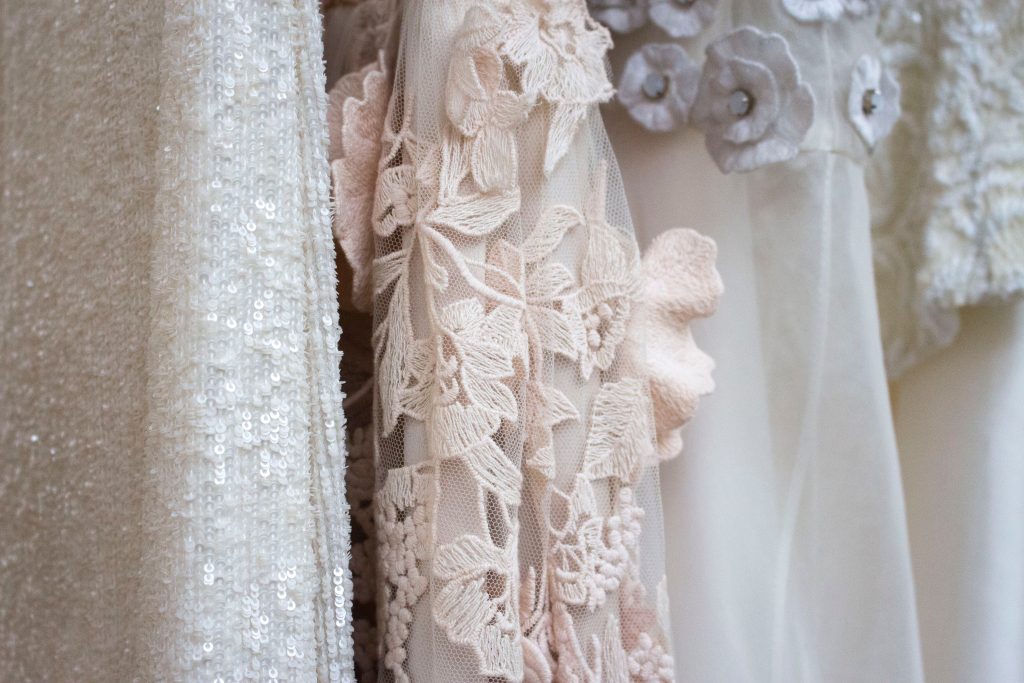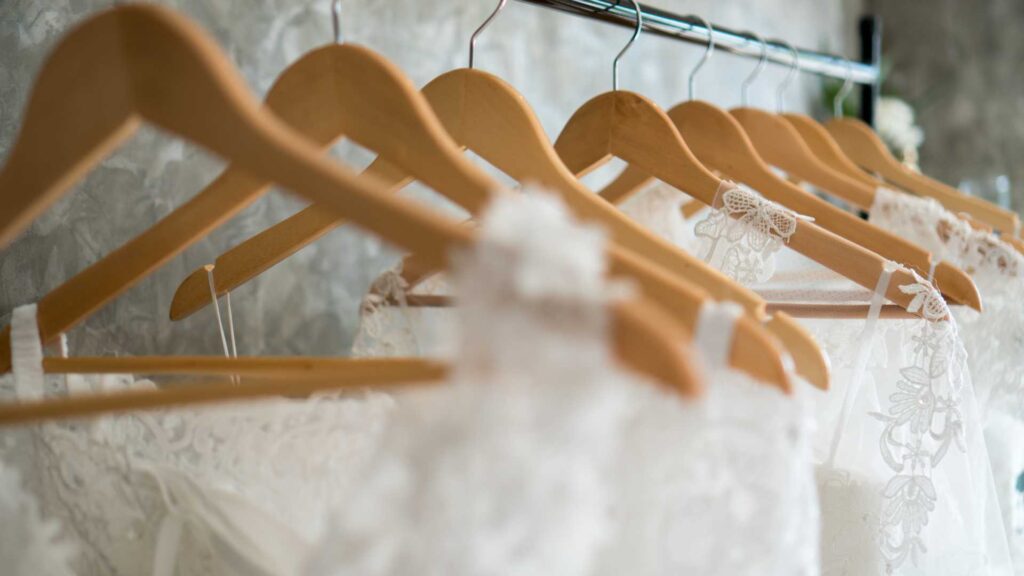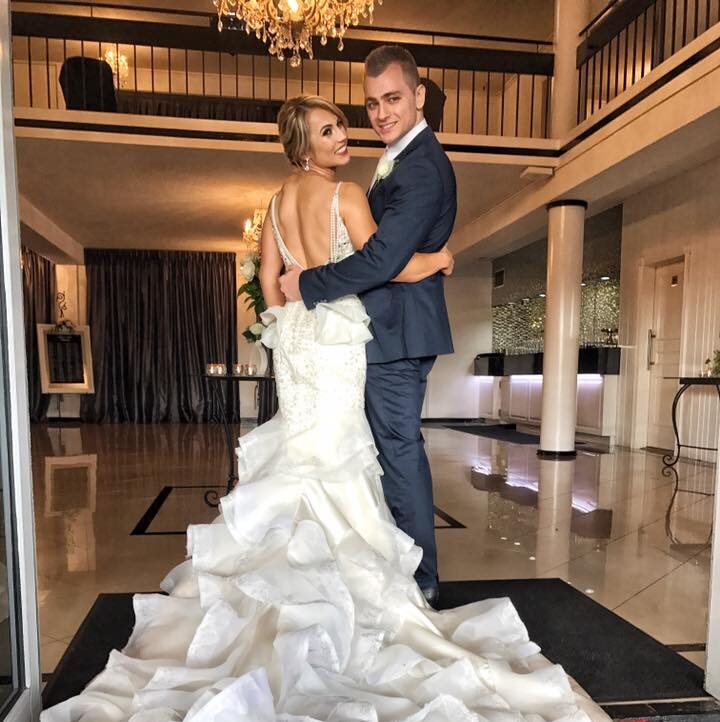Your wedding dress was the centrepiece of one of the most important days of your life, but over time, it can lose its original brilliance. Whether it’s from improper storage or invisible stains, yellowing can happen to even the most cherished gowns. I’ve seen this firsthand, and trust me, it’s not the end of the road for your dress. In this guide, we’ll dive into why wedding dresses turn yellow, and I’ll share practical tips on how to restore your gown, whether you’re looking for a DIY fix or professional help. Let’s get your dress looking as stunning as it was on your wedding day.
Why Do Wedding Dresses Turn Yellow?
There’s nothing like the anticipation of seeing your wedding dress preserved for years to come. But when you open the box and find that it’s turned a shade of yellow, it’s enough to make anyone panic. I’ve seen this happen more times than I care to count—sometimes, it’s subtle, and other times, it’s so noticeable that it’s impossible to ignore. The good news is, yellowing doesn’t have to be permanent. Let’s break down why this happens and what can be done about it.
Fabric Degradation and Oxidation
We all know that fabric, especially natural ones like silk, cotton, and linen, isn’t built to last forever. Over time, natural fabrics are prone to oxidation. This process occurs when the fabric reacts with oxygen in the air, breaking down the fibres and causing the material to slowly yellow. Even synthetic fabrics like polyester can fall victim to this process, though it’s usually a bit slower.
I recall a particular bride from Melbourne who had saved her dress for over 20 years. When she finally pulled it out of storage, the once-white gown had taken on a faint yellow hue. The combination of air exposure and natural ageing of the delicate lace had caused the yellowing. This process is often slow, but even if you store your dress carefully, oxidation can sneak up on you.
The Role of Improper Storage
Now, this is where things get tricky. Improper storage is a major culprit behind yellowing. Sunlight and humidity are like the arch-nemeses of wedding dress preservation. I’ve heard countless stories from brides who kept their dresses in humid basements or attics, only to find that their gowns had yellowed by the time they went to take them out for their anniversaries or photoshoots.
Here’s something I learned from a local bridal shop in Melbourne: Plastic bags are probably the worst thing you can store a dress in. Sure, it seems like a good idea at the time, but plastic traps moisture, and over time, this moisture can promote mould and mildew, which weakens fabric. Even worse, plastic bags release chemicals known to cause something called “phenolic yellowing,” which results in that unsightly yellow tint. If you’re storing your dress long-term, it’s crucial to store it in a breathable fabric bag – and I can’t stress this enough.
Hidden Stains and Their Impact
This one caught me off guard when I was helping my own cousin with her dress cleaning. Some stains, especially those from perfume or body oils, may not show up immediately but will eventually surface as yellow patches. It’s like a hidden battle happening between the chemicals in these substances and the fabric itself.
You know that feeling when you spray your favourite perfume before a wedding and feel the need to touch up just one more time? Well, that perfume, along with sweat and oils from your skin, can seep into the fabric. Over time, those invisible stains can break down and oxidise, leading to yellow spots.
Can a Yellowed Wedding Dress Be Restored to Its Original Beauty?

The burning question here is: can you save your yellowed wedding dress? Fortunately, the answer is usually “yes,” and I’ve witnessed numerous cases where wedding gowns have been beautifully restored to their former glory. But it’s not always a simple fix, and there are a few things to consider.
Yes, in Most Cases: The Restoration Process
In my experience, most yellowed wedding dresses can indeed be restored – though the level of success depends on a few factors, such as how yellowed the fabric is, how long it’s been stored, and the type of fabric.
For example, a client came to me a few years ago with a wedding dress that had been passed down from her grandmother. It was covered in a patchy yellowing, and she was understandably worried it wouldn’t be salvageable. I referred her to a professional restoration service, and after about 8 weeks, the dress came back as close to its original white as possible. The process involved a delicate, multi-step cleaning, including special whitening treatments and a careful assessment of the fabric’s condition. The results were impressive, and I can’t tell you how happy she was to have that heirloom gown looking brand new.
When Restoration May Not Be Possible
That being said, complete restoration isn’t always possible. Some older gowns, especially those with severe yellowing or damage from long-term degradation, may not be able to return to their original shade. I’ve also seen dresses with irreversible dark stains caused by sugar or wine stains that have seeped into the fabric over time. In cases like these, the best professionals can do is attempt to improve the gown’s overall appearance, but it may not ever be 100% restored.
Methods for Restoring a Yellowed Wedding Dress
Here’s where things get interesting. When it comes to restoring your wedding dress, you’ve got two primary options: DIY methods or professional restoration services. I’m going to walk you through both to give you a solid understanding of what each entails and help you make an informed choice.
Professional Wedding Dress Restoration
In my line of work, I always recommend going the professional route if your dress is precious, vintage, or significantly yellowed. Professional restoration services are the best option for delicate fabrics like lace, silk, or tulle, as they have the experience, knowledge, and special equipment to handle the job with care.
What’s the Process?
- Assessment: A professional cleaner will first evaluate your gown, checking the fabric type, condition of the stains, and any possible damage. This step is crucial in determining how much restoration is possible.
- Cleaning: The experts then begin a delicate cleaning process, using methods like wet cleaning, dry cleaning, and special stain-removal systems (some even use eco-friendly, gentle solutions). If the yellowing is severe, they may use an oxygen-based bleach that’s safe for delicate fabrics.
- Whitening and Stain Removal: After the cleaning, the gown is treated for whitening. Some services even use special agents to restore the dress’s original brightness.
- Minor Repairs: Often, small repairs like stitching or reinforcing delicate lace may be needed.
- Finishing Touches: Once the gown is cleaned, it’s steamed and pressed to restore its shape. Then, it’s carefully packaged for storage.
Professional services may seem pricey, but in my opinion, it’s a small price to pay to restore a dress that holds so many memories. You’re looking at an average cost of around $200-$400, with turnaround times of 6-10 weeks. For more extensive work or vintage dresses, it can take longer.
DIY Wedding Dress Restoration
While professional services are often the safest and most effective option, some brides may opt to restore their yellowed wedding dresses themselves. However, it’s important to exercise caution. If your dress holds significant sentimental value or is made of delicate fabric, it may be worth investing in a professional service.
But if you’re up for the challenge, here’s a step-by-step guide to help you with the process.
Caution: Handle with Care
Before diving into DIY cleaning, it’s crucial to consider the fabric type and condition of your dress. Wedding dresses are often made from delicate materials like silk, satin, lace, and tulle, which can be easily damaged. If the fabric is particularly fragile or the yellowing is severe, it may be safer to seek professional help.
Tip: If you decide to go ahead, start with a spot test in an inconspicuous area of the dress to ensure the cleaning method doesn’t damage the fabric.
Step-by-Step Guide for Soaking and Spot Treatment
- Preparation: Remove any metallic elements from the dress, such as eye-hooks, buttons, snaps, or zippers, to avoid rusting or snagging. Lay a white sheet or clean cloth in a bathtub or large basin to avoid stressing the fabric.
- Soaking: Fill the basin with lukewarm or cold distilled water and add a mild detergent made for delicate fabrics. The key here is to be gentle—avoid hot water, as it can damage the fabric. Soak the gown for several hours or even up to 24 hours, depending on the severity of the yellowing.
- Treating Yellowed Areas: For yellow spots, mix a small amount of white vinegar with water and use a soft cloth to gently dab the affected areas. Alternatively, baking soda can be used as a paste applied to stains, especially on lace gowns.
Tip: Oxygen-based bleach is a safer option than chlorine bleach for delicate fabrics, as it’s less likely to cause damage or discolouration. - Rinsing and Drying: After soaking, rinse the dress thoroughly with cool distilled water to remove any detergent residue. Lay the dress flat on a clean, white towel or hang it on a vinyl drying rack. Avoid wringing the fabric, as it can cause it to stretch or lose its shape.
- Ironing and Steaming: Once the dress is dry, you may need to iron it. Set your iron to the lowest heat setting and test it on a hidden section of the dress first. Alternatively, steam the dress by hanging it in a bathroom while running hot water to help remove wrinkles.
Warning: Never use chlorine bleach. It can weaken the fabric, dissolve embellishments, and may not effectively remove stains.
How to Maintain a White Wedding Dress: Preventing Yellowing
So, you’ve restored your wedding dress to its former glory. The last thing you want is for it to yellow again over time. In this section, I’ll share some tips and methods for ensuring your dress stays as beautiful as it was on your wedding day.
Proper Storage to Prevent Future Yellowing
Key Takeaway: Store your dress properly, and you’ll reduce the risk of yellowing in the future. Trust me, this is where many people fall short.
The best way to prevent yellowing is by cleaning your dress promptly after the wedding, but proper storage is equally important. Here’s what you need to do:
- Store in a Cool, Dry Place: Avoid storing your gown in attics or basements where the temperature and humidity fluctuate. Opt for a cool, dry, dark location, such as a closet away from sunlight.
- Use Breathable Storage: After cleaning, place the dress in a breathable fabric bag, not plastic. As I mentioned earlier, plastic can trap moisture and cause yellowing. You may also consider a box made of acid-free materials, which prevents yellowing over time.
- Wrap the Dress in Acid-Free Tissue Paper: When storing your dress, layer it with acid-free tissue paper to avoid creases or any unwanted chemicals seeping into the fabric. This will help preserve the fabric’s integrity.
- Avoid Hanging the Dress Long-Term: Hanging a dress for an extended period can cause it to lose its shape or even stretch. Lay the gown flat whenever possible to prevent any long-term damage.
Professional Preservation for Long-Term Care
Why Professional Preservation is Essential
If you’re serious about preserving your gown for the long haul, professional preservation is the way to go. These services clean, treat, and store your dress in a controlled, acid-free environment. They use archival-quality materials that will protect the fabric from deterioration for years to come.
Many professional preservation services also offer a guarantee, ensuring that your dress remains in excellent condition. While it’s an investment, it’s a small price to pay for peace of mind and the ability to pass your dress down to future generations.
Final Thoughts on Wedding Dress Restoration
Restoring a yellowed wedding dress is possible in many cases, and whether you choose to take the DIY route or rely on professional restoration services, there are plenty of ways to bring back the original beauty of your gown.
If your wedding dress is a treasured heirloom or holds significant sentimental value, I’d recommend going with a professional service. They’ve got the expertise and equipment to handle delicate fabrics and remove even the most stubborn stains. On the other hand, if you’re dealing with a more recent gown and are comfortable with the process, DIY methods can work just fine.
Key Takeaways
- Yellowing is common, but most wedding dresses can be restored with the right care.
- Professional restoration services offer the best results for delicate fabrics or heavily yellowed gowns.
- DIY cleaning methods can be effective but require caution and care.
- Store your gown properly to prevent future yellowing, using breathable bags and acid-free materials.
- Professional preservation services are an excellent option for long-term care.
Let’s Get Straight to the Point
Wedding dresses can yellow over time due to factors like oxidation, improper storage, and invisible stains. Fortunately, most yellowing can be restored with the right techniques. Professional services offer the best results for delicate or vintage gowns, using specialised cleaning methods and whitening treatments. DIY restoration is possible for less severe yellowing, with gentle methods like soaking and spot treatment. Prevent future yellowing by storing your dress in a cool, dry place and using breathable storage. For long-term preservation, consider professional services that guarantee the gown’s condition for years to come.



